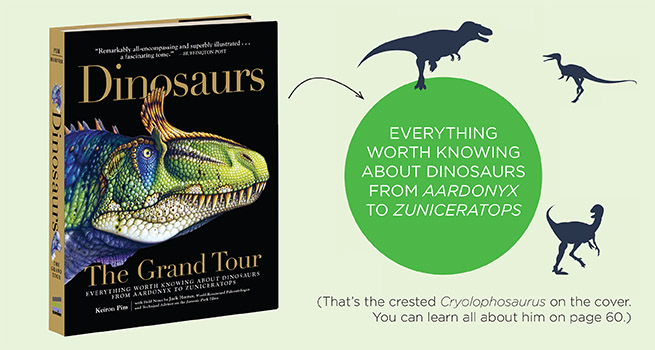This guest post comes from Keiron Pim, author of Dinosaurs—The Grand Tour. With the news on the brontosaurus (Is he, or isn’t he?) and the soon to be released Jurassic World movie, just how fast is the world of dinosaurs changing?
 If there is one thing I learned above all while writing Dinosaurs: the Grand Tour, it was that our understanding of the dinosaur world changes so fast it can be hard to keep up. However, if you mention that to someone with little interest in the subject they’ll likely react with amusement. Dinosaurs, those ancient reptiles whose fossil bones are removed with painstaking care from rockfaces and quarries… how quickly can such a subject move, really?
If there is one thing I learned above all while writing Dinosaurs: the Grand Tour, it was that our understanding of the dinosaur world changes so fast it can be hard to keep up. However, if you mention that to someone with little interest in the subject they’ll likely react with amusement. Dinosaurs, those ancient reptiles whose fossil bones are removed with painstaking care from rockfaces and quarries… how quickly can such a subject move, really?
But with several new species announced every month on average, the casual dinosaur enthusiast need only look away for a few weeks to find that when they look back again, the findings have changed in their absence. One week an analysis places Archaeopteryx as a bird, then another team of palaeontologists argues it’s ‘only’ a feathered dinosaur akin to Velociraptor owing to an anatomical feature it shares with a newly discovered bird-like dinosaur; then a reassessment places it back in the birds again. One day we’re picturing only a certain swathe of theropod dinosaurs as feathered, then Kulindadromeus is unveiled bearing no relation to the kind of dinosaurs we previously knew to have ‘dino-fuzz’, and we have to imagine the possibility that a feathery covering was present to some degree across the whole spectrum of dinosaur life.
That said, there is one enduring and unshakeable fact that anyone half-interested in the subject knows: there’s no such thing as a Brontosaurus, rather, there is only what is known as an Apatosaurus. As I describe in my book, the context of its discovery was the infamous ‘Bone Wars’, a 19th century scientific feud between rival palaeontologists Othniel Marsh and Edward Drinker Cope, whose battle to find the most fossils led to some rather hasty and later-revised scientific classifications. The huge sauropod – the largest dinosaur yet discovered at that time – that Marsh found at Como Bluff in Wyoming and named ‘thunder lizard’ turned out in 1903 to be a new species of his earlier discovery Apatosaurus. So Apatosaurus took priority and Brontosaurus was expunged from the records, only to live on in our collective memory owing to its irresistible name.
Except, this “indisputable” fact now appears uncertain too. A new assessment of the fossils in question has concluded that there are actually significant differences between those two species, enough to resurrect Brontosaurus as a dinosaur in its own right. The 300-page study’s lead author, Portuguese palaeontologist Emanuel Tschopp, told Scientific American: “Generally, Brontosaurus can be distinguished from Apatosaurus most easily by its neck, which is higher and less wide. So although both are very massive and robust animals, Apatosaurus is even more extreme than Brontosaurus.”
Of course, nothing is proven beyond doubt. Science never is. Instead, palaeontologists offer interpretations from the available evidence, knowing that new evidence could suggest new theories. On the one hand there are scientists such as Mike Taylor, a sauropod expert at the University of Bristol in England who I consulted when researching my book, who are highly impressed by the meticulous five-year study. He spoke of its “magnificent comprehensiveness” that “really sets a new standard,” leaving him “in awe of the authors.” Incidentally one of those co-authors is Roger Benson, a palaeontologist at the University of Cambridge who was also kind enough to help me when I wrote my book’s entry on one of his specialisms, the Jurassic predator Magnosaurus. On the other hand others urge caution, noting that the authors themselves deem their findings disputable and concluding that further testing of the study’s vast number of hypotheses is required.
One thing is for certain – the affair has proven to anyone who didn’t already realize it that the dinosaur world never loses its capacity to surprise us. I can’t wait to find out the next twist in these incredible animals’ story.
 As a small boy in the early 1980s nothing seemed more exciting to Keiron Pim than a visit to the Natural History Museum, where he would gaze up at the Diplodocus skeleton and later depart clutching some little dinosaur-related memento: an eraser shaped like Stegosaurus, a lurid poster of a Jurassic scene, or a book crammed with dino facts. It would have blown his four-year-old mind to know that thirty years later a book on dinosaurs would be his first publication. Keiron, married with three young daughters, is a writer and journalist based in Norfolk, England.
As a small boy in the early 1980s nothing seemed more exciting to Keiron Pim than a visit to the Natural History Museum, where he would gaze up at the Diplodocus skeleton and later depart clutching some little dinosaur-related memento: an eraser shaped like Stegosaurus, a lurid poster of a Jurassic scene, or a book crammed with dino facts. It would have blown his four-year-old mind to know that thirty years later a book on dinosaurs would be his first publication. Keiron, married with three young daughters, is a writer and journalist based in Norfolk, England.


